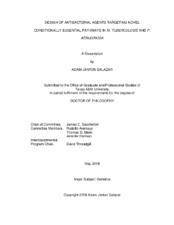| dc.contributor.advisor | Sacchettini, James C | |
| dc.creator | Salazar, Adam Janton | |
| dc.date.accessioned | 2019-10-15T15:59:59Z | |
| dc.date.available | 2021-05-01T12:35:35Z | |
| dc.date.created | 2019-05 | |
| dc.date.issued | 2019-02-12 | |
| dc.date.submitted | May 2019 | |
| dc.identifier.uri | https://hdl.handle.net/1969.1/184380 | |
| dc.description.abstract | This dissertation covers projects focused on the drug design and characterization of novel bacterial drug targets. The first project centers on acetolactate synthase (ALS), a key enzyme involved in the biosynthesis of bacterial branched chain amino acid biosynthesis. ALS is found in plants and is the known target of commercial herbicides of the sulfonylurea and triazolopyrimidine sulfonamide (TPS) classes. We devised an improved ALS enzyme assay capable of high-throughput scaling to test the inhibition of these compounds and determined that several were potent inhibitors of Mycobacterium tuberculosis growth and ALS activity. Here, we report the SARs of TPS inhibitor penoxsulam derivatives, and verify their on-target activity via the generation of intragenic suppressor mutants and loss of TPS inhibition in the presence of pathway end-products. We also present a closed-form M. tuberculosis ALS homology model from plant AHAS in complex with penoxsulam. Docking revealed possible mechanisms underlying several SARs.
The second project revolves around a myophage-like tail fiber of R-type pyocins. This tail fiber is capable of specific attachment to strains of Pseudomonas aeruginosa, making it a useful molecular adhesin for drug delivery. We investigate the structure of R pyocin tail fibers using constructs that correspond to a region of variation between R-subtypes. This region is sufficient for specificity and forms an elongated helical trimer composed of three domains arranged linearly from N- to C-terminus. The head and shaft domains contain novel structural motifs. The foot domain, however, is composed of a conserved jellyroll fold and shares high structural similarity to the AP22 tail fiber, podophage tailspike C-terminal domains (LKA-1 and ɸ297), and discoidin.
The third project involves the glyoxylate shunt enzymes isocitrate lyase (ICL-3) and malate synthase (MSG) of P. aeruginosa. Bioinformatics of bacterial ICLs elucidates that Pseudomonads contain either ICL-3 or ICL-1. We report the structure of P. aeruginosa ICL-3, which contains notable surface structures different from ICL-1. We also report that Phenyl-diketoacid inhibitors of M. tuberculosis MSG inhibited P. aeruginosa growth. We reveal the structures of P. aeruginosa MSG with these inhibitors bound and verify their inhibition of P. aeruginosa MSG by enzyme assay | en |
| dc.format.mimetype | application/pdf | |
| dc.language.iso | en | |
| dc.subject | SBDD | en |
| dc.subject | structure | en |
| dc.subject | crystallography | en |
| dc.subject | branched chain amino acids | en |
| dc.subject | isocitrate lyase | en |
| dc.subject | malate synthase | en |
| dc.subject | | en |
| dc.title | Design of Antibacterial Agents Targeting Novel Conditionally Essential Pathways in M. Tuberculosis and P. Aeruginosa | en |
| dc.type | Thesis | en |
| thesis.degree.department | Biochemistry and Biophysics | en |
| thesis.degree.discipline | Genetics | en |
| thesis.degree.grantor | Texas A & M University | en |
| thesis.degree.name | Doctor of Philosophy | en |
| thesis.degree.level | Doctoral | en |
| dc.contributor.committeeMember | Aramayo, Rodolfo | |
| dc.contributor.committeeMember | Herman, Jennifer | |
| dc.contributor.committeeMember | Meek, Thomas | |
| dc.type.material | text | en |
| dc.date.updated | 2019-10-15T15:59:59Z | |
| local.embargo.terms | 2021-05-01 | |
| local.etdauthor.orcid | 0000-0002-4614-0952 | |


